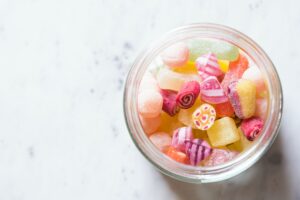 Sugar is the one of the hardest “foods” to give up. We get “the sugar blues”, in a sense. Or I we can get – sugar rage for some. Sugar is the generic name for a sweet-tasting, soluble carbohydrate. Simple sugars, also called monosaccharides, include glucose, fructose, and galactose. What does sugar do to our bodies? In the best case senario it’s used as fuel. But we need to use the sugar in an appropriate amount of time, and if not, and isn’t used it is stored in the body. Where? -you guessed it, fat. Sugar is also very toxic in our bodies in high doses, or most importantly, when it can’t be processed. (think diabetes or insulin resistance) where the sugar can’t get into the cells to be used as fuel. Sugar will create high inflammation, weight gain, high cholesterol, fatty liver disease, high blood pressure, and stresses the heart and arteries to name a few.
Sugar is the one of the hardest “foods” to give up. We get “the sugar blues”, in a sense. Or I we can get – sugar rage for some. Sugar is the generic name for a sweet-tasting, soluble carbohydrate. Simple sugars, also called monosaccharides, include glucose, fructose, and galactose. What does sugar do to our bodies? In the best case senario it’s used as fuel. But we need to use the sugar in an appropriate amount of time, and if not, and isn’t used it is stored in the body. Where? -you guessed it, fat. Sugar is also very toxic in our bodies in high doses, or most importantly, when it can’t be processed. (think diabetes or insulin resistance) where the sugar can’t get into the cells to be used as fuel. Sugar will create high inflammation, weight gain, high cholesterol, fatty liver disease, high blood pressure, and stresses the heart and arteries to name a few.
The sugar blues come when we are addicted to sugar, the brain literally is waiting for certain chemicals to be made after ingesting sugar, and when the body doesn’t receive that information we can get very cranky. The brain perceives sugar as beneficial which releases huge amounts of dopamine, a neurotransmitter, that is responsible for feelings of pleasure, satisfaction and motivation. However, when we consume sugary, high-calorie foods in the long term, it can mimic the effects of addiction. This will create a higher tolerance for sugar and even cravings. The sugar blues happen from this withdrawal when we cut it out of our diets, even though this is a good thing, we will go through a hard few days to many weeks of getting over this hump.
Balancing our blood sugar is not as easy as one thinks, or you may think, “I don’t eat that much sugar”. I do in fact hear this frequently. But once we start talking about it and writing a food journal, there is a realization of how much sugar is going into our mouths daily. Sugar does not just in one the form of candy, it shows up in the many forms of different carbs. After you eat a meal, your body breaks down carbs in digestion into glucose (sugar). Glucose gives your cells energy. The glucose moves into the bloodstream, and your blood sugar level rises. The sugar that isn’t needed to fuel your body right away gets stored in cells for later use. This storage becomes higher and higher as we consume too much sugar, and then turns to fat. Candy makes this process even go faster.
So, it’s the holidays, how can we keep sugar to a minimum and still have a good time? What can we do to treat ourselves during the year without over consuming too much sugar? The FDA says,”The Daily Value for added sugars is 50 grams per day based on a 2,000 calorie daily diet. For most Americans, the main sources of added sugars are sugar-sweetened beverages, baked goods, desserts, and sweets.” When 4g of sugar is 1 teaspoon, this is equivalent to 12 and 1/2 teaspoons per day. 1 teaspoon of honey is 6 grams of sugar. I just can’t understand this at all. I don’t know anyone working out this much to be able to burn this much sugar in energy per day. With sitting becoming the new norm with so many having computer jobs this is nearly impossible to burn.
How do we get through the sugar blues when we decide to clean up the diet, eat less carbohydrates for a healthy lifestyle? Most turn to sugar substitutes, and the problem with this is that they still taste like sugar, so it keeps you in the loop of craving it and wanting it more and more, even though your blood stream isn’t spiked with glucose, the craving is still there so you end up eating more.
Tips for getting off of the sugar addiction and getting out of the sugar blues:
At first use the sugar substitutes so you can feel better, knowing you will eventually need to ween yourself of those as well, and/or use them sparingly.
Sugar substitutes come in many forms, and some better than others. Honey and maple syrup are extremely sugary to your system as they are higher in grams than raw sugar alone, however, they are packed with more benefits like vitamins and minerals, even a little fiber, which is why they are more beneficial to you.
Here are some better choices when it comes to sugar substitutes
- date sugar
- honey
- maple syrup
- molasses
- stevia
- xylitol
- tubinado
- evaporated can juice crystals
Be careful of GMO sugars and sugar alcohols: These should all be avoided.
- Beet sugar
- Corn Syrup
- Dextrose
- Erythritol
- Maltodextrin
- Maltose
- High Fructose corn syrup
- sorbitol
- isomalt
- Mannitol
- glycerol
Sugars are lurking everywhere in our condiments, salad dressings, soups, crackers, lunch meats, food additives, cereals, fruit juices, sauces, and when we see “low fat” think loaded with sugar, which is the complete opposite of low fat, its actually fattening. A great way where marketing can literally pursued what we think.
Enjoy this holiday season, and pick your choosing when it comes to the sugar overload. Once we indulge just a little or a lot we get hooked it as our chemicals start taking over in the body. We notice the changes pretty fast and when you can clue into your own bodies changes from sugar you won’t go through the sugar blues too often.
If you would like to dive in a little deeper into your nutrition please reach out to me or book a free call here
In Health,
Jen
Sources:
https://www.fda.gov/food/nutrition-facts-label/added-sugars-nutrition-facts-label



